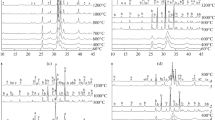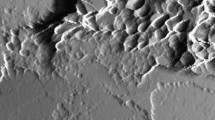Abstract
The formation of hydroxyapatite by an acid-base reaction between solid calcium phosphates at temperatures from 5 to 60 °C was examined. The basic reactant used is Ca4(PO4)2O, while the acidic reactants include CaHPO4, CaHPO4 · H2O, and Ca(H2PO4)2 · H2O. Rates of heat evolution during reaction were determined by isothermal calorimetry. The variations in the proportions of reactants and hydroxyapatite and the formation of intermediate products were assessed by x-ray diffraction. Development of microstructure was observed. Generally, hydroxyapatite formation occurs by rapid initial reaction followed by a period during which reaction occurs slowly. Apparent activation energies calculated for the reaction when CaHPO4 is the acidic reactant show differing values depending on its surface area. When the acidic reactant is Ca(H2PO4)2 · H2O, intermediate products are formed. At low temperatures the intermediate is CaHPO4 · 2H2O, while at higher temperatures it is CaHPO4. Above 38 °C, the rate during the period of slow reaction decreases with increasing temperature. This appears to be related to the retrograde solubilities of the reactants, CaHPO4 · 2H2O and CaHPO4, and of HAp.
Similar content being viewed by others
References
W. E. Brown and L.C. Chow, Cements Research Progress-1986, edited by P. W. Brown (American Ceramic Socielv, Westerville, OH, 1987), pp. 351–379.
M. Fulmer and P. W. Brown, in Male-rials Synthesis Utilizing Biological Processes, edited by P. C. Rieke. P. D. Calvert, and M. Alper (Mater. Res. Soc. Symp. Proc. 174, Pittsburgh, PA, 1990), p. 39.
M. Fulmer and P. W. Brown, J. Am. Ceram. Soc. 74. 934–940 (1991).
P.W. Brown. N. Hocker, and S. Hovlc, J. Am. Ccram. Soc. 74, 1855–1861 (1991).
M.T. Fulmer, R.I. Martin, and P.W. Brown, J. Mater. Sci. Materials in Medicine (in press).
P.W. Brown, J. Am. Ceram. Soc. 75, 17–22 (1992).
H.F. W. Taylor, Cement Chemistry (Academic Press. New York, 1990).
S-S. Feng and T.J. Rockett, J. Am. Ceram. Soc. 62, 619 620 (1979).
T. M. Gregory. K. G. Moreno, J. M. Petal, and W. E. Brown, J. Res. Natl. Bur. Stand. 78A, 667–674 (1974).
J. VanWazer, Phosphorous and Its Compounds, Vol. I: Chemistry (1958).
H. McDowell, T. M. Gregory, and W. E. Brown, J. Res. Natl. Bur. Stand. 81A, 273–281 (1977).
R. Martin and P.W. Brown, unpublished work.
B. B. Tomazic, M.S. Tung, T. M. Gregory, and WE. Brown, Scan. Micro. 3 (1), 119–127 (1989).
W.E. Brown, J.R. Lehr, J.T. Smith, and A.W. Frazier, Nature 196, 1050–1055 (1962).
R.Z. LeGeros, G. Daculsi, J. Orly, T. Abergas, and W. Torres Scan. Micro. 3 (1), 129–138 (1989).
Author information
Authors and Affiliations
Rights and permissions
About this article
Cite this article
Fulmer, M.T., Brown, P.W. Effects of temperature on the formation of hydroxyapatite. Journal of Materials Research 8, 1687–1696 (1993). https://doi.org/10.1557/JMR.1993.1687
Received:
Accepted:
Published:
Issue Date:
DOI: https://doi.org/10.1557/JMR.1993.1687




